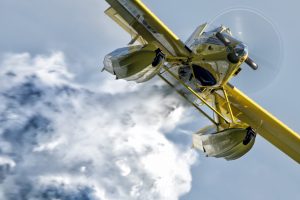On 4th June the Swedish Civil Contingencies Agency (MSB), informed about the purchase of two new so-called light scooping aircraft for fighting wildfires in Sweden. They are included in the rescEU reserve and will serve in Sweden and the rest of northern Europe. They will be stationed at Skavsta Airport some 100 km south of Stockholm.
Scooping waterbombers
Earlier this year an agreement was signed between MSB and Saab AB, who will be the supplier, incl. crew and other logistics, of the two aircraft. The two aircraft are ready to be used from the 3rd of June. As part of the rescEU the project is 90 % financed by the EU.
“This is an important step to improve the wildfire-fighting capacity in Sweden and northern Europe”, says the General Director of MSB, Mr. Dan Eliasson according to a press release from MSB and continues, “the problem with wildfires can become even bigger in the future due to climate change”.
The make and model of the aircraft is Air Tractor AT-802 Fire Boss. The water capacity is 3 000 liters per bombing and plane. As mentioned above the planes are stationed at Skavsta Airport but they can if necessary be placed elsewhere.
Photo: Saabgroup.com
Summer 2014 is not forgotten (?)
On the 31st of July 2014, a spark from a forest machine lit a wildfire that developed to be the most devastating wildfire in Sweden ever so far. Over 13 000 hectares of forest were destroyed, over 100 forest owners were affected. One person, a timber truck driver, was killed during the fire.
The legal aftermath of the fire in 2014 is still going on.
2018 – here we go again
Already in late 2014, it was much discussed if the Swedish authorities were actually capable of handling a disaster like the big fire in 2014. Commissions and investigations were launched by the government. The question now is; Did it do any good?
In late May 2018, the first wildfires were reported to the authorities. When summer 2018 was summarized in August, over 50 wildfires of a total 25 000 hectares had been reported all over Sweden. 7 000 firefighters from 10 countries (apart from Sweden) were operating with planes, helicopters and ground crew to put out the fires.
The town and community of Ljusdal in central Sweden was the place that was most affected by wildfires in 2018. Here five fires of total of 9 500 hectares were going on at the same time.
No persons were injured or killed during the fires in 2018.
No forest machines this time
It´s worth pointing out that no fires summer 2018 was started by a forest machine. The machines in the forest were parked with the memory of the fire in 2014 in mind. Lightning and careless people were the main reasons of the fires in 2018, and of course the drought.
But again, it seems Sweden hadn´t learned the lesson. We didn´t have our own aircraft. Some of the helicopters that were available were not used from the start. There were many testimonies about how communication didn´t work. There were misunderstandings between neighboring communities resulting in that firefighters in some cases didn´t know where to go.
It seemed that everybody was working in their own area and there was no one that had an overall view – in the beginning. Over time it was understood that this was a very special situation and the organization turned from bad to fantastic.
The firefighters were treated like the heroes they were. Volunteers turned up from everywhere, just like food and drink for the fighters. When it was over everybody on the field had done a great job.
Common sense
As being an old forest man, knowing how important forestry is to the nation Sweden, I can´t help wondering why Sweden has not had firefighting aircraft in such a long time? Ok, I know that they are expensive and that Sweden hasn´t had that many big wildfires in history. But still – compared to the net profit coming from our forests, that´s peanuts!
As for the organization, if there was a war coming up – Would every town only defend itself and don´t give a damn about the others? I don´t think so. The defense would be focused on the spot(s) where the attack comes, and it would be controlled from a national level. I mean, if your neighbor´s house is on fire you´ve got to help. Otherwise, your house can catch fire as well. Why has this strategy not been used also when it comes to wildfires?
Let´s hope for a wet summer
Well, I will stop complaining. Now we have two planes, paid by the EU but still … They are here, ready to go! Let´s hope we will never need them.
This is a film made by MSB at the presentation of the planes on 4th June 2020:
Photo: Saabgroup.com
Film: MSB (the Swedish Civil Contingencies Agency)
Sources: MSB, Ljusdals Kommun, Swedish Forestry Agency (Skogsstyrelsen)












